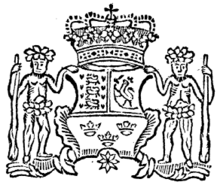Adresseavisen
Adresseavisen (Urban East Norwegian: [ɑˈdrɛ̀sːə.ɑˌviːsn̩]; commonly known as Adressa) is a regional newspaper published daily, except Sundays, in Trondheim, Norway.[1]
The front page of the Norwegian newspaper Adresseavisen ("Trondhjems Adresseavis") from the 17 May 1905. | |
| Type | Newspaper |
|---|---|
| Format | Tabloid |
| Owner(s) | Adresseavisen Media Group Polaris Media Schibsted ASA |
| Editor | Arne Blix |
| Founded | 3 July 1767 |
| Political alignment | Conservative |
| Language | Norwegian |
| Headquarters | Trondheim, Norway |
| Circulation | 61,582 (2015) |
| Website | adressa.no |
Adresseavisen is owned by Polaris Media, in which Schibsted controls 29% of the shares.
History and profile

The newspaper was first published on 3 July 1767[1][2] as Kongelig allene privilegerede Trondheims Adresse-Contoirs Efterretninger, making it the oldest Norwegian newspaper still being published. The paper was founded as a classified advertising publication.[3] The name of the newspaper was changed several times before its present name began to be used in 1927.[4] Locally it is often referred to as Adressa. The newspaper is based in Trondheim[2][5] and covers the areas of Trøndelag and Nordmøre.
Martinus Lind Nissen (1744–1795) was the founder and first editor of Adresseavisen. At his death, Nissen was succeeded by Mathias Conrad Peterson, a French-oriented revolutionary pioneering radical journalism in Norway. Later editors, however, have been more conservative. In Peterson's age the paper was renamed Trondhjemske Tidender (roughly Trondhjem Times) and began to look more like a modern newspaper. Changing names, owners and profile several times during the 19th century, the paper was named Trondhjems Adresseavis in 1890. Its first press picture was published in 1893. During the 1920s, the paper was nearly bankrupted, but it was saved by the new editor, Harald Houge Torp, who held the position until 1969.
Adresseavisen describes itself as conservative[2] and is part of the Adresseavisen Media Group which owns several smaller local newspapers in the Trøndelag region.[3] It also owns and operates a local radio station, Radio-Adressa, and a local TV station, TV-Adressa (prior to 30 January 2006: TVTrøndelag). In addition, the company owns the local newspapers Fosna-Folket, Hitra-Frøya, Levanger-Avisa, Sør-Trøndelag, Trønderbladet and Verdalingen.[3] As of 2006 Schibsted had a share of the paper (31.7%).[2] Stocks in Adresseavisen are traded on the Oslo Stock Exchange.
Adressavisen became the first Norwegian newspaper to use computer technology in 1967. Its website was launched in 1996. Gunnar Flikke was editor-in-chief from 1989 to 2006. Adresseavisen switched from broadsheet to tabloid format on 16 September 2006.[6]
Circulation
The circulation of Adresseavisen was 87,000 copies in 2003,[7] 79,789 in 2007[8] and 61,086 in 2014.[9]
The online newspaper Adressa.no had an average of 155,000 daily readers in 2015.[10]
See also
Notable chief editors
- Martinus Nissen (1767–1795)
- Matthias Conrad Peterson (1795–1800)
- Harald Torp (1927 – 1941, 1945 – 1969)
- Jacob Skylstad (1941–1945)
- Andreas Norland (1975–1977)
- Kjell Einar Amdahl (1977–1996)
- Gunnar Flikke (1989–2006)
- Arne Blix (2007–2015)
- Tor Olav Mørseth (2015–2017)
- Kirsti Husby (2017 – incumbent)
References
- Sigurd Allern (2007). "From Party Press to Independent Observers?". Nordicom Review (Jubilee Issue): 63–79. Retrieved 12 December 2014.
- "The press in Norway". BBC. 20 February 2006. Retrieved 24 January 2015.
- "Norwegian media group uses innovative strategies to become a cross-media powerhouse". CCI Europe. Archived from the original on 28 January 2015. Retrieved 24 January 2015.
- "Printed history". The Hindu. 2 July 2015. Retrieved 26 May 2016.
- "Norway". Press Reference. Retrieved 7 March 2015.
- "A Small World – Role Models In Scandinavia" (PDF). Göteborgs University. 2007. Retrieved 6 February 2015.
- "World Press Trends" (PDF). World Association of Newspapers. Paris. 2004. Retrieved 15 February 2015.
- Eva Harrie (2009). "The Nordic Media Market" (PDF). Nordicom, University of Gothenburg. Göteborg. Retrieved 23 April 2015.
- "Opplagstall norske aviser" [Circulation of Norwegian newspapers. 2014] (in Norwegian). Media Norway. Retrieved 16 October 2016.
- Statistics from TNG Gallup via MedieNorge, http://medienorge.uib.no/statistikk/medium/avis
External links
- Adresseavisen's online edition
- Historical issues from 1767 onwards at the National Library of Norway
| Wikimedia Commons has media related to Adresseavisen. |